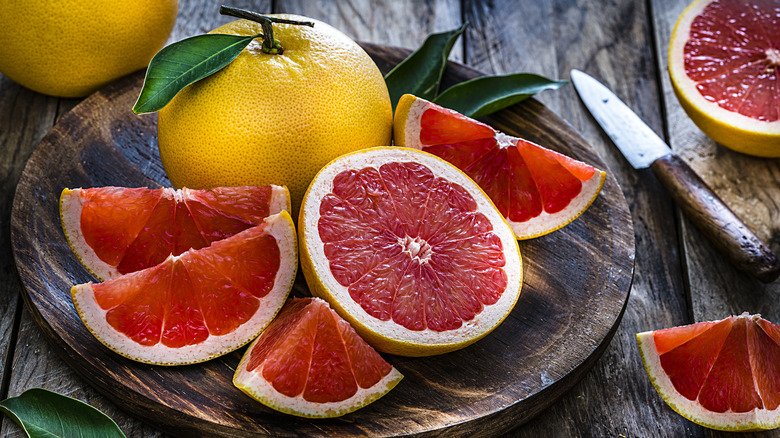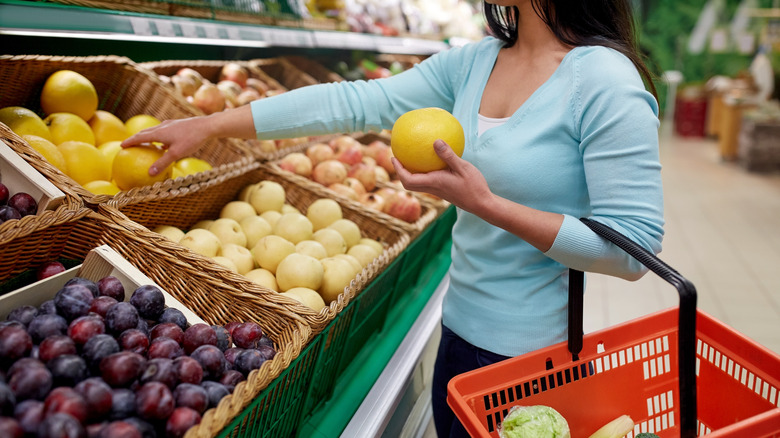How To Choose The Tastiest Grapefruit At The Store
When looking for the tastiest fruit at the grocery store, some fruits give away their ripeness more easily than others, whether by how they look, smell, or feel. You can judge a perfectly ripe bunch of bananas by its color; a basket of ripe strawberries by the berries' bright red hue and intoxicating scent; and an avocado that's ready to eat by how it feels when you press it with your finger. Other fruits require a bit more investigation, like watermelons, which are notoriously difficult to judge without cutting them open, though the two-finger trick can be helpful. Almost as difficult to unravel are citrus fruits, particularly grapefruits.
Grapefruits are covered by a thick rind, which makes it difficult to judge their ripeness on smell alone. Different varieties come in different colors, so unless you know what kind of grapefruit you're looking at in the market, judging ripeness only by color can be complicated. It's best to rely on three elements when choosing the best grapefruit: color, weight, and firmness. And, yes, you do need to consider all three, and not just one.
Three signs of a good grapefruit
Whatever kind of grapefruit you're looking at, the color of the skin should be fairly uniform. If it's Ruby Red grapefruit you're shopping for, the skin should have an even apricot or sunset hue with perhaps a blushing of darker pink. Meanwhile, a white grapefruit should have an even lemon-yellow skin. If you see any green patches, the fruit isn't fully ripe yet (with the exception of some varietals like Oroblanco and Melogolds, which have naturally green skin).
Most grapefruits are quite large, especially when compared to other citrus fruits like oranges, lemons, and limes, and when you hold a grapefruit in your hand, it should feel as heavy as it looks. If it seems unusually light, put it down and select another. Juice is what adds weight to a grapefruit, so lightness could be a sign that the fruit inside has dried out and shriveled.
If the color is even and the weight feels right, go ahead and give the fruit a light squeeze. It should feel firm, but if it feels downright soft and squishy, then the fruit is overripe and really isn't good for eating anymore.
Ripe grapefruit is a culinary superstar
A perfectly ripe grapefruit is an exciting citrus to eat. Most varietals are sweet, tart, and a little bitter all at the same time, which gives unexpected layers of flavor to cocktails, desserts, condiments, relishes, and salads, not to mention a pop of beautiful color.
Two of the most well-known grapefruit-forward cocktails are the Greyhound, which combines vodka and grapefruit juice, and the Paloma, which is a sparkly, refreshing drink that includes tequila, lime juice, grapefruit juice, and a little simple syrup. You can also try substituting grapefruit juice in any drink that calls for lemon juice, and see if you like it.
From a sweet standpoint, fresh grapefruit juice can be used to make curds (akin to lemon curd), dessert bars, cakes, sorbets, and tarts. Ripe segments of grapefruit can be added to all kinds of salads (fruit or vegetable ones), or mixed into a bright citrus and avocado relish for fish tacos. Use the zest of the fruit to flavor sauces like hollandaise, or to mix it into sugar cookie dough. And, finally, remember that one of the best ways to enjoy a perfectly ripe grapefruit is to cut it in half and scoop out the juicy segments to enjoy on their own.



